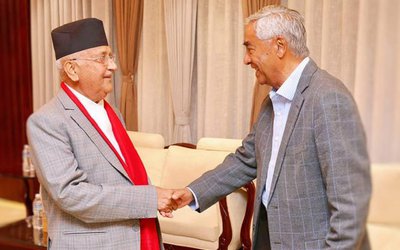Background
This nation’s experience to free oneself from the autocratic rule of Rana Regime ended in 1951, but it did not produce well-functioning democratic constitutional monarchy under another autocratic rule of Shah dynasty. After nearly four decades of dynastic rule of Shah, which had assumed absolute power, was also deposed by peoples’ popular movement of 2007. This followed bi-cameral parliamentary system encapsulating federal democratic republic, contemplating three-tiered governance structure but apparently without essential in-depth contextual analysis of pros and cons of the system in Nepal’s geographic and economic silhouette and, again, without adequate advance preparation of implementation strategies and time table to complete the process of power delineation, and most importantly fiscal implications, relevancy and effective functioning of hierarchical state structures in this poor nation which was, for centuries, trapped in intergenerational poverty.
Constitution drafting, looked like a lackluster exercise that took nearly seven years of preparatory consultations among 601 members and two Constituent Assemblies. This delay demonstrated inability of political parties and the elites to forge a pragmatic consensus on the way forward to state structure and governance system although parties were already fantasizing, prior to adoption of new constitution, that new nation state will be a plurality of democratic and republic, and incomparable to past practices and fix nation’s socio-economic malaise. To the ignorance of public, this euphoric lip-service, displayed then, as it appeared now a hollow promise of what was to be revealed in coming years in implementation of the letters and spirit of all-inclusive constitution.
Context
Constitution drafting delays was a clear indication of inherent difficulties in forging inter-party consensus across all political parties and elites remained far apart in articulating detailed mechanisms and functioning of state governance. Draft document was, nevertheless, produced during the time when nation was devastatingly shattered by two major earthquakes of April/May 2015 and when people displayed displeasures in government’s ambivalence and inaction in relief and recovery efforts for mitigating miseries and sufferings of the victims of this nature’s wrath. Observers believed new draft constitution was the product, upon realization of possibility of becoming politically irrelevant under the growing public disenchantments on parties’ failures to participate in relief and recovery drive.
New constitution was promulgated in September 2015 without detailing on how and when the devolution of power in the proposed three-tiered governance structures. No public referendum was undertaken on this egalitarian constitution. Post-facto recollection reveal that the two Constituent Assemblies (CA) were heavily dominated by majority members of conglomeration of communists and Nepali Congress, jointly representing no less than 79% of the total CA members. Parties then decided to solicit only a select provisions of the constitution in public domain for opinion/comments. But there is no evidence if inputs received from the public were incorporated in the final release of the constitution.
The rationale for not seeking public endorsement on the entire document of high national value, which must become the supreme law of the land, is unknown in pubic. This reluctance did display political establishment had no appetite for engaging into wider consultations with pubic. It also reflected that political genius in Nepal who were still in euphoric jubilation of political transformation and could not bother the importance of seeking peoples’ endorsement. Political elites were overconfident of their power, authority, and control over people and nation.
After declaration of Federal Democratic Republic of Nepal in May 2008 successive governments were established and following the general election in 2017 government was set up in February 2018. Country was in jubilation in the development. This elevated peoples’ aspiration and expectations on better days ahead. However, political events that shortly followed the period, were not showing promise for neither governments nor parliamentarians were keen on pursuing national economic development strategy and policy issues for tackling socio-economic inequalities in the country. No priority debates were held on economic pathways for common prosperity of people with the same intensity and fervor as they had delved time and energy on party interests in their tenures.
Politics is about power and influence. Inordinate focus and time spent on politics demonstrate political elite’s excessive fixation on political power, authority, control, and influence. They have not shown willingness to articulate realistic and attainable economic future of the nation, as they perpetuate their future survival, and as such, party ideology and political philosophy become mere illusions in the present-day Nepal. Reported pre-election collaborative dependence between the parties of ideologically opposed and radically contradicting political philosophies is a testimony that demonstrates democracy’s delirium if we are to recapitulate it.
Tyranny of political party culture
Political transformation was expected to transform Nepal into a success story in Asia and beyond, provide stability, peace, prosperity, and inter-communal harmony, and swiftly embark on realistic and pragmatic economic development in peoples’ common prosperity by lifting poor citizens out of multi-dimensional inter-generational poverty, incomparable of the time. Instead, it has fallen into a state of abyss due to manufactured instability and squabbling over political power. Result: Nation’s political economy became prisoner of political parties and elites, and democratic functioning came under serious duress. Is there any hope for freeing the nation out of this challenging environment?
Nepal’s political transformation was a historic achievement because it was largely bloodless, swift, and short in duration. But it has failed to demonstrate good governance. Political elites appear enjoying living under the euphoria of glory, power, and kept telling population that nation is in the best of the modern times. How could this be true when successive governments failed to improve standards of life and well-being of citizens, create conducive environment for healthy living with sense of security. Further, governance system has failed to visualize tangible economic accruals to majority of population by enhancing purchasing power in parity of households need, comparable of the time. This would have, presumably, discouraged exodus of youths in desperation of better education, jobs, and opportunities.
Widespread corruption, nepotism, impunity, and excessive political maneuvers have become norms of governance. Political interferences in state institutions that provide services to public have systemic problem touching every sphere of peoples’ daily affairs. Even judiciary, law, and order are of no exception. This is seriously eroding public trust and confidence in liberal functioning of democracy. Irreparable intra-party fissures have contributed to mal governance and state apparatus have become dysfunctional. This situation is accentuated by installation of a government, for example, through a judiciary injunction of 2021, with political influence.
State dysfunction is evidenced by exodus of youth, dwindling exports, depleting foreign exchange reserve, rising cost of living, dependency on imports of staple food items, and low wage, to cite few examples. Governments have no credible plans to fix economic development, poverty, and social malaise. This helped richer to grow rich and powerful when poorer segments of society are not growing up. This is widening socio-economic inequalities deeper.
Who is responsible for this situation? Why should ordinary citizens shoulder one of the highest taxes in the sub-continent (in GDP per capita terms: World Bank data) when people in political positions and power are enjoying luxury, and VIP culture continues and funded by taxpayers?
Political discourses related to development issues are replaced by ‘pride projects’ of little or no economic relevance, disastrous ‘dozer-development’ mania and ‘Ashaare Bikash’ mantra. This is streamlined by rush to transfers of taxpayers’ monies to unaccounted ‘Beruzu’ fund at the near end of fiscal year. This is a definition of political development and new modes of state corruption. This is convenient because of lack of accountability and performance auditing for measuring financial performance of public funds.
We are nationals of a proud nation, but the world perceives us poorly, just above Afghanistan and Somalia. For years green Nepali passport is ranked one of the weakest in the world. This will never change unless the nation becomes wealthier in real terms. But it is unlikely to occur in this century in the way country is being run and governed. Time and again, only one thing one hears is political party interests and wranglings over political power, authority, control, influence under the cover of pseudo nationalism and sovereignty.
Concluding remarks
Political governance and institutions should not show any erosion of credibility, democratic principles, republican values, and socio-cultural norms of civility which are integral part of any respectable society and nation. Dumping political philosophy and ideologies for gaining a seat of power through pre-election collaborative dependency is a deceit and political corruption. No wonder why Nepal has been listed, for years, as one of the most corrupt nations in Transparency International Corruption Index in public sector, citing institutions like nation’s high executive, bureaucracy, security, and judiciary.
It is not incorrect to say that Nepal’s political transformation was only about re-affirming supremacy of party rule in a system of rotational musical chair of power by consolidating absolute intra-party and/or inter-party mechanisms, resembling like party autocracy with plutocracy at play. This fixation for political power and control mania is an epidemic that has gripped the nation’s psychic and rooted in our socio-economic DNA, and, hence, political elites reject ‘think again’ beyond ‘out-of-the-box’.
Political transformation failed to expedite development, growth, and common prosperity. Ironically, Nepal has become politically unstable, economically volatile, and unsecured.
It is a nation of high intellectual acumen and self-assured compassionate political elites, but still lacking courage to officially recognize Nepali migrant workers as the real “Economic Heroes of Nepal” for sustaining country from probable economic collapse for so many years.
Are we now fully prepared and equipped with adequate tools and coping mechanisms in case of sudden shifts in geo-political and economic scenarios for we live in an inter-connected world of today?
(The author, Kedar Neupane is a board member of Nepal Policy Institute, an independent international think-tank, and a retiree United Nations staff. Observations, views, and comments expressed in this piece are author’s personal. Neupanek1950@gmail.com)

Kedar Neupane
He can be reached at Neupanek1950@gmail.com
- Talking About South Asian Diaspora Community And Its Economic Prowess In The USA
- Aug 23, 2023
- Talking About Growth Miracle And Emerging Quadripolar Economic Construct (Part – Two)
- Jul 28, 2023
- Talking About Growth Miracle and Emerging Quadripolar Economic Construct (Part – One)
- Jul 02, 2023
- Pseudo-Nationalism Is About Political Desperation And Sure Sign of Economic Collapse Context And Background
- Jun 19, 2023
- Realities In Conflict Of Interest And Challenges Of Combating Corruption In Nepal: PART -TWO
- Jun 08, 2023














